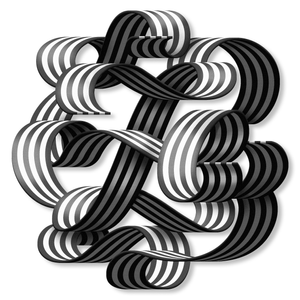How to Build a Brand: Branding 101
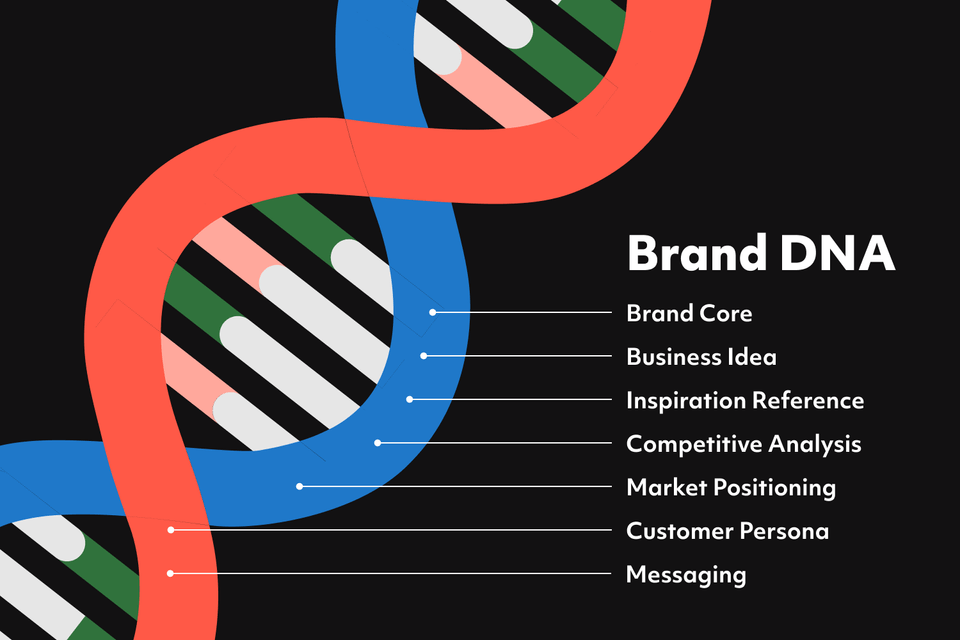
Define your Brand Core, Business Idea, Inspiration Reference, Competitive Anlaysis, Market Positioning, Customer Persona, and Messaging
Branding Your Business
Welcome to ZeBrand. Your brand is the most important aspect of your business operation, even more than the products or services you offer. Your brand is what sets you apart from your competitors, and it’s what differentiates you in the minds of your customers. A strong brand has a unique vision at its core that guides everything it does, from how it goes to the market to the types of partnerships you make and to the internal company culture. Your brand idea should solve many of your operational problems with the same solution. Critically, your brand is what appeals to consumers’ emotions. It’s what draws them in and makes them want to grant your company the privilege of entering their lives. The strongest brands in the world are so good at this that consumers will literally use them as badges of their identity because they connect so strongly with what the company stands for.
Oftentimes, people make the mistake of thinking that a brand is only a logo, visual presentation, and colors. While these are important aspects of the brand for sure, there is so much more. A brand is also a vision or a mission. At the center of your brand should be why you exist. Any company can offer the same products and services, but they don’t all share the same reason for being. Increasingly, consumers want to connect with the values and vision of a company. Additionally, your brand should also have a consistent tone of voice it takes in its messaging, advertising, thought leadership, and social media communications.
Don’t worry, ZeBrand enables you to do all of this effectively. Let’s take a closer look at how the process works.
ZeBrand’s Branding Approach
Branding is not a one-time, set it and forget it process. Instead, it’s an ongoing process for as long as the brand exists. We offer a continuous branding process that keeps the three steps of define, design, and deliver in rotation.
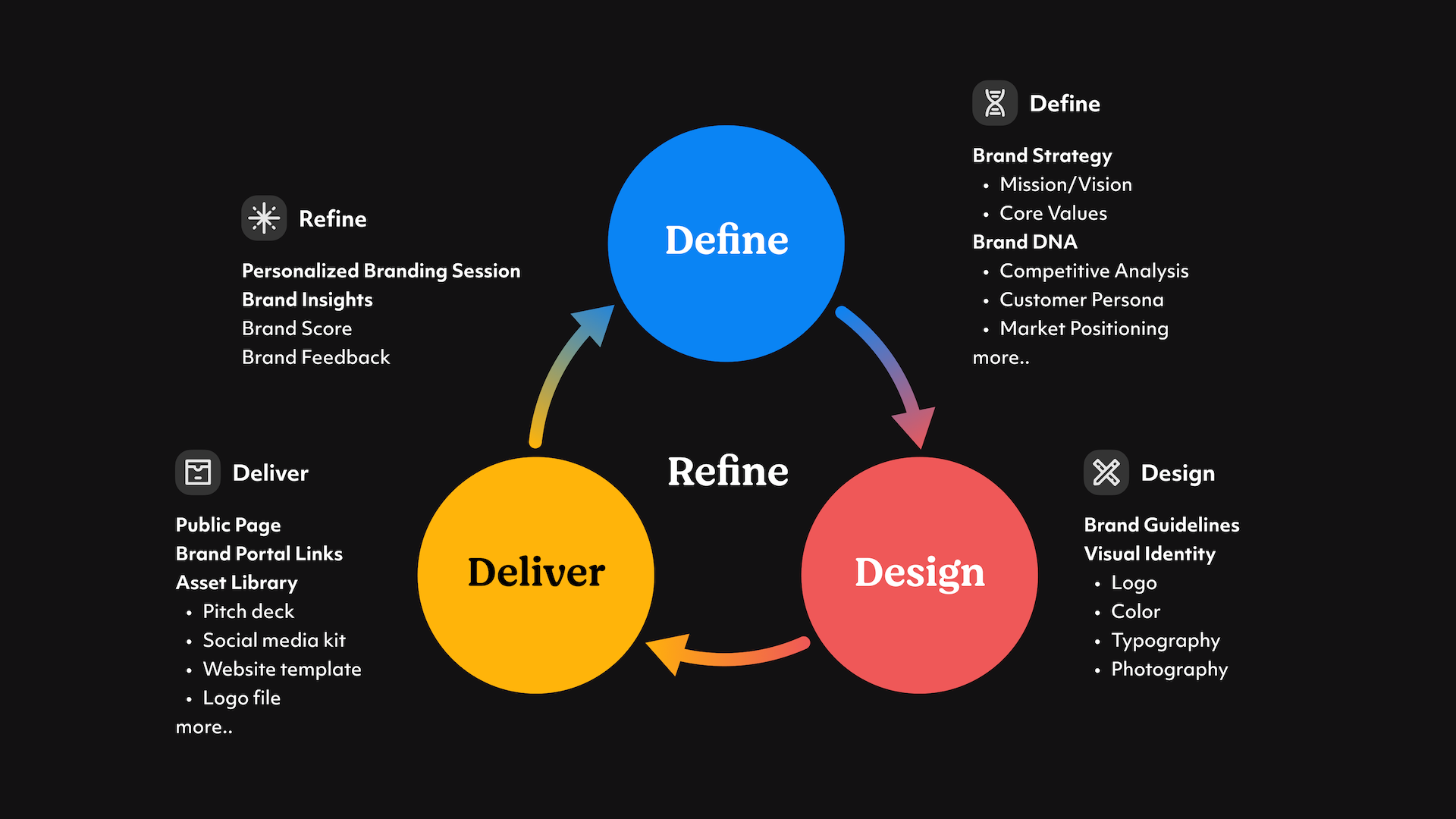
Step 1: Define
The brand definition phase is critically important, and therefore, it comes first - even before colors, logos, photography, and style guides. In the brand definition phase, you will first sharpen your brand story. Your brand story includes your reason for being and your brand’s why. It includes your brand’s mission statement. And finally, it includes your brand’s values.
Your brand story is what will draw your customers in and allow them to connect with you emotionally. For almost all new companies, an established set of competitors already exists who are offering similar products and services. So your brand story is, at least initially, the only thing that sets your brand apart.
ZeBrand’s process will ask you thought-provoking questions that help you isolate the key elements that make up your brand story and lay the foundations for future success. After you’ve completed your initial strategic modules for your brand, we offer coaching sessions with experienced brand strategists who will work with you personally in a Zoom session to help answer any questions you may have or eliminate any roadblocks you may be experiencing. Brand coaches are highly valuable resources available to you to help you finalize a brand story that stands out and that you feel good about delivering.
Step 2: Design
After you’ve locked down your brand story, the next step is to translate that into a design and visual system for your brand. Let’s say your brand sells sustainable dog and cat products, and you exist to improve the lives of both pets and the planet. This will obviously impact how your brand should look, feel and present visually. Humans are accustomed to reading visual cues as shortcuts for information. If this was your brand, you’d likely want to use planetary colors, like greens and blues, etc., to cue what your brand stands for. This is why it’s best branding practice to develop your brand story before you get into designing your visual identity, fonts, logo, photography style, and color palette. All of these visual aspects communicate in nanoseconds when your customers encounter your brand. That is why it’s critically important that they work to build the meaning you want, and they help tell your brand story for you.
ZeBrand’s design platform enables you to translate the values, moods, and feelings you want to convey and then seamlessly develops a design system and style guide for your brand. You’ll walk away from ZeBrand with a design system that plays off your brand story and is ready for you to begin using to bring your brand into the world.
Step 3: Deliver
The last step in ZeBrand’s iterative process ensures you deliver your brand to the world effectively. Once you developed a resonating, compelling brand story and you’ve translated that story to visual identity, you’ll need help creating brand assets like websites, pitch decks, and social media kits.
ZeBrand has you covered there too!
Steps to Build a Brand
Here are some examples of how you can go about building a brand, managing a brand, or rebranding with ZeBrand.
Example 1: Create a New Brand
- Review the Branding Checklist to see which elements you’re missing.
- Try to fill out your Brand DNA and Brand Guidelines to the best of your ability.
- Check in with a Brand Coach and get feedback and advice on your brand story. In this first brand coaching session, your brand coach will help you arrive at actionable next steps to tackle before meeting again.
- When you are ready to launch your business, please apply to our Spotlight on Brands, where we feature your mission and brand story on our Instagram
- Later, learn more about the wants, needs, and desires of your audience with a brand survey.
- Check in with your Brand Coach again to review your progress and answer any lingering questions you may have.
- As you go along, if you need any updates on your Brand DNA or Brand Guidelines, consult with your Brand Coach again for a third session.
Example 2: Manage Your Brand & Considering a Rebrand
- Review the Branding Checklist to see which elements you’re missing.
- Try to fill out or reflect your brand’s information in your Brand DNA and Brand Guidelines
If you need to rebrand,
- Check in with a Brand Coach for guidance and to confirm what you still need to create for your rebrand.
- Finalize a list of what you need to create and do, like a logo or a presentation template. This list will be your action items moving forward. You will check in with your brand coach periodically to ensure you are making the progress you want.
- When you’re ready to move into design, you will design your Visual Identity with a Design Coach.
- At some point, send your brand survey to your audience to see how how the brand elements are performing from their perspective.
- Finally, if you need any updates on your Brand DNA or Brand Guidelines, consult with your Brand Coach in a third session.
Brand DNA
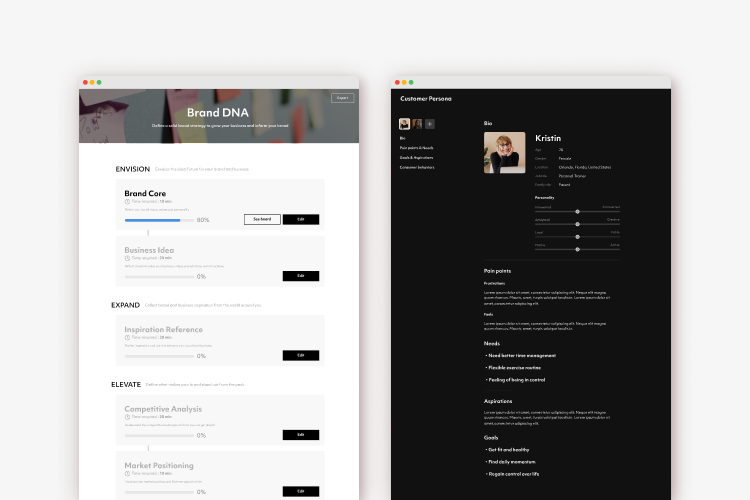
Every brand's DNA is different, just as every person's DNA is different. You can create your unique brand by clarifying and clearly expressing the base DNA that makes up your brand.
Use the Brand DNA boards to organize and build the core elements of your brand.
- Envision - Envision the ideal future for your brand and business
- Expand - Collect brand and business inspiration from the world around you
- Elevate - Define what makes your brand stand out from the pack
- Expression - Create a framework for expressing your brand visually and verbally
Pro Tip: Everything in your DNA should be core to your brand. It is the essential building block of your business that informs the rest of your brand.
Brand Core
Brand Core includes the brand name, vision, values, and brand personality. As the name implies, the Brand Core shouldn’t change very often. It is the most evergreen part of your brand. It will be something that the brand will set forth to move forward unwaveringly. The Brand Core is a reference point when you are unsure of a decision or if your brand is at a crossroads.
Business Idea
Reflect on what makes your business unique and what goals you want to achieve. By gaining clarity on critical factors like target audience, potential partners, revenue models, and resources, you will understand the basic framework of how to make your business work.
Customer Persona
If you try to make your brand appeal to everybody, you’ll appeal to nobody, and the results won’t be as sharp and emotionally resonant as they need to be. A customer persona is a singular representation of your ideal target audience based on your user research. It is a valuable tool to synthesize your findings and goals into clear actions and behaviors in the Customer Persona template.
Tip: Don't get caught up in minor details of your persona that aren't relevant or are random. Remember that your idealized portrait should be representative of your user research.
For example, below are guidelines for translating your customer persona into your brand’s look and feel:
Introverted: Your look and feel should be calm and somewhat quiet. Clear, negative space and plenty of breathing room in your designs will be key.
- Extroverted: Your look and feel should feel energetic and exciting. Your tone of voice and how you speak to your audience will be key.
- Analytical: Your look and feel should feel intelligent, clean, and professional. Look for fonts with a trustworthy sense and nice numerals to make your stats shine.
- Creative: Your look and feel should be expressive. Think about how to make your photography style (or even illustration style) unique and evocative.
- Loyal: Your look and feel should feel grounded and confident. Your tone of voice and messaging will ensure a sense of trust.
- Active: Your look and feel should feel energetic. Look for fonts that have impact and movement, and use action words in your messaging.
Inspiration Reference
Inspiration for business, branding, and design can come from anywhere. Yes, they can come from other businesses and people, but they also exist in books, movies, on the road, and in conversation. You can also find them in philosophy, literature, and the arts. So look far and wide.
This exercise allows you to collect and keep track of these various input sources to provide a mood board for your brand and business. Your inspiration is designed to help you translate the feelings that caused you to start a business to the wider world.
Tips:
- Source: Look far and wide. From historical movements to fine art, books to objects, cultures to individuals, inspiration can be found everywhere. Don’t decide whether it’s relevant enough just yet—if there’s something interesting there, keep a record of it here for future reference.
- Summary: Keep this short. You just need two or three sentences to jot down your thoughts as a reminder for yourself when you return to this board later.
- Similarity: Everything shares similarities one way or another. What aspects or elements resemble parts of your brand? It might be a specific design feature or as broad as an emotional feeling.
- Specialty: Ask yourself what makes this thing unique. What drew you to it? What makes it significant and meaningful? What allows it to work the way it does?
- So what?: Think tangibly. What can you learn or gather from this piece of inspiration? What aspects of your brand—whether it’s product features or communication style—can benefit from it?
Competitive Analysis
It is vital that you understand the competitive landscape to differentiate your brand effectively. You will examine relevant competitors to understand the positioning they are taking in the marketplace so that you can identify an ownable “white space” to occupy that is very different. Lastly, it enables you to compare yourself to your competitors on various dimensions, such as pricing or communications. It's a valuable and objective way to assess your brand and business.
You can use this information to decide your communication strategy and visual languages. How do the competitors sound, what colors do they use, and what personalities do they use? How would your brand like to express itself in response?
Market Positioning
Visualize your market position and find new opportunities. It's how your customer might perceive you in comparison to competitors. Most importantly, it will help you get a clearer picture of where you want your business to be headed. (Competitors are synced from the Competitive Analysis module.)
Messaging
Your brand story and messaging are the foundation for all of your communications and even your business pitch. Create a cohesive story to introduce yourself to the world. Think of it as your elevator pitch. Understanding the changes in your customers' thinking and behavior in response to changes in the world can help you figure out how you should move and respond.
What’s Next? After completing your Brand DNA, we recommend you book a session with a brand coach to review.
Pro Tip: Revisit your DNA whenever there’s a big change in your business – such as a change in leadership, pivot in business, or big milestone anniversaries – to ensure that everything is still relevant and up to date.
Brand Strategy
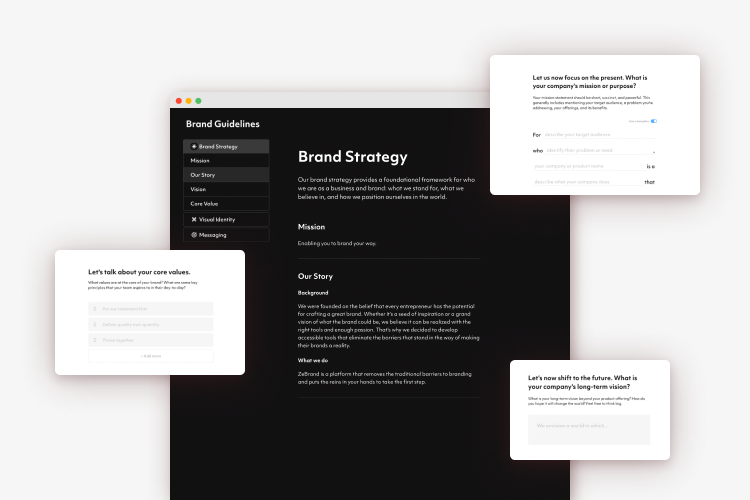
Make sure your brand decisions align with your business decisions and needs. Your Brand Story should be interesting and compelling to audiences. Make sure your vision and mission are clearly communicated.
Do you have any apparent contradictions? You want to make sure your brand strategy is in sync, and all aspects ladder up to and express one singular core idea and emotional takeaway for your customer. Inconsistency in your brand's core concept and core emotion won't allow you to use it as a filter for your decision-making.
Pro Tip: Try not to be too vague with your strategic choices or language. The more specific and clear your strategy is, the easier it will be to use it as a filter to make decisions. When you try to design for everybody, you are designing for nobody.
Vision Statement
Does your vision statement express the WHY of your company in a compelling and emotional way? Your company's vision is why you exist and started what you did. The WHY is how you will make an emotional connection with your prospective audiences, so it's critically important. For example, Airbnb's "Belong Anywhere."
Mission Statement
Does your mission statement reflect WHAT your company is trying to accomplish in the world? It should clearly indicate to potential customers what your company is trying to do. Your customers will be attracted to your mission, but they need to know what it is.
Core Values
Your core values are what support your vision statement or your WHY. You have a reason for being - WHY you exist - and what core values lead to that reason for being? To continue the Airbnb example, if their WHY is belong anywhere, then you could see how their core values might be things like "empathy," "peace," etc.
What We Do
ZeBrand provides you a template for asking yourself the right questions to sharpen your brand DNA (your WHY WHAT HOW). It also allows you to translate your completed brand DNA into your brand identity (your look and feel - e.g., colors, photography, logo, etc.). In short, ZeBrand enables you to get unstuck and take the first steps in the right direction.
Brand Story
Your brand story is a succinct "elevator pitch" of what your company is all about: WHY you exist, WHAT you do, and HOW you do that. You want to aim for a short, emotionally compelling pitch that unites these elements.
Frequently Asked Questions on Brand Strategy:
- How do I make/decide on a brand?
- How do I know if my brand is good?
- What is brand strategy?
- When should I change my brand or brand strategy, and how do I know?
- How long are brands good for?
What’s Next? Your visual identity/brand guidelines that follow your brand DNA
Pro Tip:
- Book a meeting with a brand coach to discuss your thinking with you. They have lots of experience with developing a brand strategy, so they will be able to help you make it even sharper/better.
- After you meet with a brand coach, make the agreed-upon edits/changes, and finalize your Brand DNA board.
- Then you're ready to move to the next step of the process and use your completed Brand DNA board to guide your answers to your brand visual guidelines. Your visual guidelines should always follow your Brand DNA.
Visual Identity

Make sure the right fonts, colors, logo, and imagery are being used throughout your materials. Make sure your brand “looks and feels” right and appeals to your target audience. Make sure your Visual Identity is aligned with your Brand Strategy,
Logo
The logo communicates ownership, quality, and values. It's imprinted on your products, business cards, website, social media, and most importantly, in the minds of your clients.
Your logo is likely to be one of the first interactions people have with your company, and it's your opportunity to make a solid first impression, show you deliver a quality service, and visually express your purpose.
Color
The primary color should be the dominant main go-to color, whereas the secondary color is proportionally less. They may be used in less prominent cases as small accents/highlights.
Font
Typography adds personality to your brand voice. It helps to communicate their brand image quickly. Use the same brand typography on your website, social media, pitch deck, and other marketing materials to keep your brand look–and sound– consistent.
Tip: Take into consideration the font license when you use it. There are strict rules for paid fonts.
Photography
Brand imagery is the visual representation of your brand's core message. It results from all the elements that consumers associate with your brand. You can choose and create your photography library within the Asset Library.
Brand imagery aims to convey the right message to your target consumers and create a strong emotional response when they encounter your brand.
What’s Next? After completing your Visual Identity, we recommend you finish your Brand Guidelines or check and download your Brand Assets.
Pro Tip: Brand Design requires test-driving to see what works and doesn't. Don't expect to get everything right all at once. Instead, start using your Brand Elements to see what needs to be edited or expanded upon. Apply it to various channels and materials to see how flexible or rigid your system needs to be.
Brand Guidelines
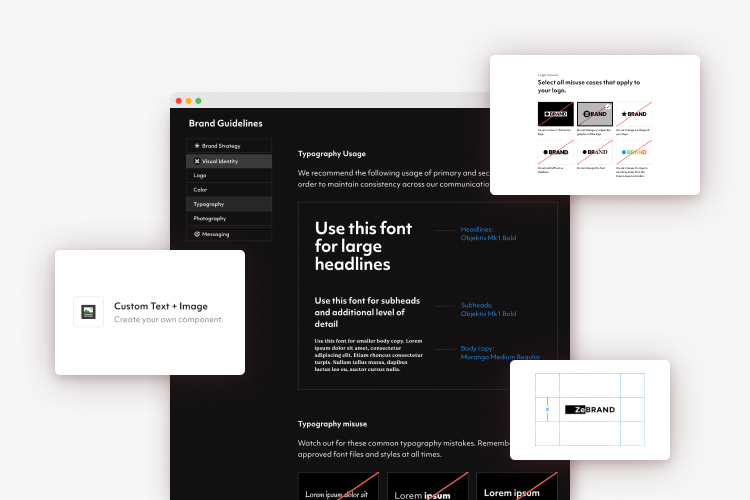
Firstly, share your Guidelines with collaborators so that they can begin test-driving your brand. You won’t know how effective it is until another person starts using it.
Observe how your team is using and interpreting the guidelines: What’s working (where are people most successful?), what’s not working (where do people need more support or clarity?), and what do the results look like (do your materials look on-brand?)
When start-up founders and small business owners create a brand, you’ll likely work with the bare minimum visual elements (a “starter pack”). However, as your business grows, you will need to expand and refine your elements to ensure it addresses all of your growing needs and touchpoints.
All other entrepreneurs, keep observing your brand from a high-level view: Does everything look consistent? Does anything feel off? Does this feel right for your brand and the target audience you are trying to reach? If not, it may be worth relooking at your guidelines.
ZeBrand’s Brand Guidelines include:
- Brand Strategy
- Visual Identity
- Primary Logo
- Clear Space
- Logo Misuse
- Primary Logo files
- Social Media Icons
- Secondary Logo
- Color
- Primary Font
- Secondary Font
- Typography Usage
- Typography Misuse
- Font
- Photography
- Messaging
- Tagline
- Customize Components (add whatever else you’d like within Visual Identity)
- Share
See a sample of ZeBrand’s brand guidelines here.
Clear Space
It is important that the corporate mark be kept away from other graphic elements. To regulate this, a clear space is often established around the corporate mark. When you use a logo, it must be surrounded by a clear space to ensure its visibility and impact. This area should not contain graphic elements of any kind.
Logo/Symbol Misuse
It is a very important visual element, and we all need to use that element correctly. However, if anyone misuses it, it can damage the brand and its integrity. So, it is necessary to clearly state the do's and don'ts so that everyone can easily understand.
Building brand recognition is the main priority, so you want to ensure not to hinder this by altering the official logo.
Examples:
Do not outline or frame the logo: This tends to result in a "sticker effect," which isn't the most elegant solution for placing your logo. If you need to place your logo against a dark background, try to use the inverted version of the logo. If it needs to be placed on a busy background, try to create white space for the primary logo to be placed in, rather than boxing it in.
Do not outline the symbol: Depending on the complexity of your symbol, this may change the shape or visibility of your symbol as outlined shapes do not scale down as well as solid shapes.
Of course, there are exceptions to the rules, depending on the complexity of your logo and the look you are going for.
Typography Usage & Misuse
There are many best practices for typography, and setting guidelines ensures consistency.
Primary font is usually used for headlines and large-scale copy such as titles, divider slides, banners, graphics, and social posts. The secondary font is used for small-scale copy such as body copy such as long paragraphs, descriptors, small labels, and sub-items.
How to use: Share your Brand Guidelines with designers, writers, and marketers for visual and tonal consistency –regardless of who is creating brand communications; it will serve as a reference point for specific design specs, color values, elements, and inspiration. It can also be an onboarding tool for familiarizing new team members and collaborators with the brand (first intro to a brand). Essentially it's a document that serves as the "official" source of truth: for documentation of add brand additions or edits.
What’s Next? Create a Brand Feedback form and get feedback from your audience. Once you identify areas for improvement, revisit your ZeBrand modules. If you feel stuck, set up a 1:1 session with a Brand Coach.
Pro Tip: Your brand is never done. Make sure it evolves and grows parallel to your business growth and any significant milestones.
Brand Assets
Brand assets are all of the things your brand “owns” and considers an asset in its business operations. Typical assets are websites, photography, social media, typography, etc., before eventually, advertising and marketing. Brand assets help businesses scale their business by providing pre-designed assets that will allow them to stay on-brand whether they’re launching a new product or expanding markets.
Website
Make sure the right fonts, colors, logo, and imagery are being used.
Photography
Curate a diverse enough image library that addresses your various needs while maintaining a clear and distinct "look."
Typography
Ensure you use the correct fonts and understand the different use cases between your primary and secondary fonts.
Social Media logo
Make sure you use your logo icon (instead of the full logomark) to maximize your profile icon space. Also, use platform-specific assets since the asset sizes are optimized for each platform requirement.
Pitch Deck
Make sure every page is purposeful, clear, and concise. Make sure it tells a story about your brand (verbally) and demonstrates the overall look and feel (visually). Don't overcrowd pages with too much text or visual elements. Simplicity and clarity are key.
See a sample of ZeBrand’s brand assets here.
Asset Libary
An Asset Libary is a dedicated place to manage and save all your brand assets. Think of it as your digital asset management system, where you can always find what you’re looking for. Upload original full sizes and approved materials to eliminate misplacing or losing assets. It’s easy to save and easy to find, which will simplify your workflow.
Brand Portal Links
Brand awareness is essential for brand growth. Brand Portal Links aggregate information about a user's brand and deliver it to their audience. User’s brand guidelines and brand story pages are automatically reflected, making it quick and easy to share the uniqueness of your brand.
What’s Next? Ensure your assets are well organized and that your team can easily find what they need. Add any brand assets made outside of ZeBrand to ensure everything lives in one place.
Pro Tip: Organization of brand assets is key to good brand management.
Brand Insights
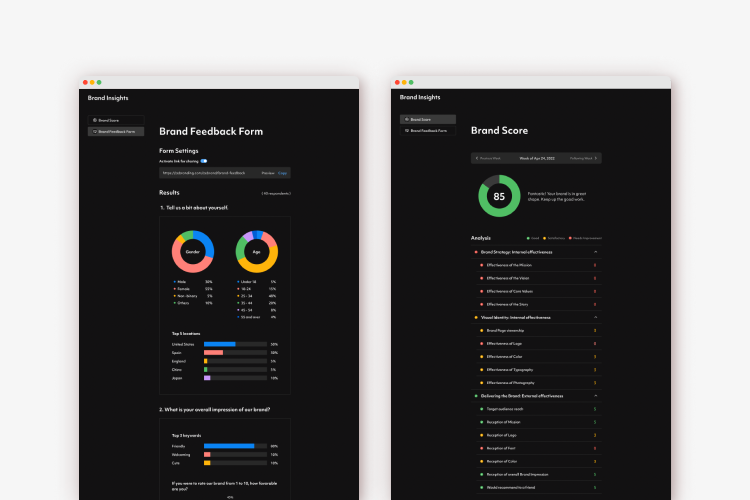
Brand insights can be tricky to define and uncover, which is why there are entire disciplines of marketing professionals, called brand strategists, whose job is to research and discover them.
At the most basic level, insights are grounded in the psychology of your customers or in the changing cultural currents. You know you have an insight when it helps you look at the world differently than before because you’ve made a new connection between two things that you didn’t see fitting together before.
You can uncover brand insights within ZeBrand by engaging with your target audience through the Brand Feedback Form or introspectively reviewing your brand's current state with the Brand Score feature.
If you ever feel at a loss about what to do after reviewing the brand insights, don't worry, as your brand coaches have lots of experience defining strategies for it.
Brand Feedback Form
We believe that branding works if we have a good match between what we think of the brand and how your end-user feels. Brand feedback gives users visibility into how end-users think about their brand and what end-user base their brand is reaching. If there is a difference, something may not be working, so it’s essential to evaluate.
It’s important to learn how the users’ audience perceives their brand. Users can now send out the Brand Feedback Form to see what their customers think. It's crucial for them to bridge the gap between their brand's intentions/vision and how it's currently being perceived.
They can send the pre-made survey to their audience to discover the perception gap and use the feedback to build a stronger brand. When a user creates or uploads a brand identity in ZeBrand, a survey like this one will be sent to them.
Then the results will be all wrapped up beautifully within their Brand Insights page. The user can analyze and improve parts of their brand based on this valuable feedback. They can also consult with a Brand Coach on the insights and determine whether they should pivot their brand strategy to close the gap.
Brand Score
In the early stages of launching a brand, it is difficult to withstand change because the business model and brand identity have not been finalized. We believe that a brand that can firmly establish its brand vision and continue to advance its vision will evolve into a solid brand in the future. To this end, we have released Brand Score to help users view themselves objectively.
The Brand Score gives the user a snapshot of how their brand is performing right now. Maintaining a high score over a long period indicates good branding. Data that affect the score are things like user ratings, team satisfaction, and account activity. The Brand Score will be low if you don't have the data from the Brand Feedback Form, so users should gather it as soon as possible.
To learn more, read Uncovering Brand Insight Through Brand Feedback and Brand Score.
Multi-Brand Management
Think web developers, business coaches, consultants, social media managers, and brand strategists. All these entrepreneurs have one thing in common, and that’s managing multiple clients. It can get overwhelming to create separate accounts, so ZeBrand has a feature where you can manage it all through one account.
If you have multiple brands for yourself or as clients, you can use the multi-brand management feature. If you are interested, please contact support@zebranding.com.
Brand Coach
Brand Coaches help you think through your brand strategy, craft the story you want to tell, advise on whether your brand design communicates your business strengths, etc.
Brand Coaches are brand strategists to help you take the proper steps to grow your business. They will be the ones who have your back when you start to worry.
You can get access to 45-minute virtual sessions with Brand Coaches. If you're on the Premium Plan subscription, you can consult with your coach every month. They will recommend your next steps.
Frequently Asked Questions during a branding session:
Question: Tell me how I should do brand strategy.
Answer: Start with Brand DNA boards and a good sense of the WHY, HOW, and WHAT of your business, and then schedule a meeting with a brand coach to work on it together.
Question: How long is a brand strategy good for? When should I update/change my brand strategy, and how do I know?
Answer: Define your brand DNA on ZeBrand, and this should be the foundation that propels your brand forward for the next 3-5 years.
Question: What makes a good brand strategy?
Answer: Accounts for your customers (persona), your market (analysis of the competition and their messaging), and your brand DNA your WHY HOW WHAT = Brand DNA board.
Question: How do I know if my brand strategy is right/good?
Answer: Does it express a POV on cultural tension today? Does it move your target customer emotionally? Does it signal to potential customers that your brand gives them something to believe in and belong to? ZeBrand: meet with a brand coach to go over your brand DNA.
Build Your Brand Today
We hope you’re more inspired than ever to brand your business your way with ZeBrand. Launching a brand and business is sure to be one of the most rewarding things you’ll ever do. There’s clearly a strong passion that brought you here. Now it’s time to realize it. While it can seem like you have to do it all yourself, this couldn’t be further from the truth. Anyone who’s ever launched a brand did it with the help of others: with the help of confidants, friends, and family, with the help of business partners and consultants, with the help of your customers whom you learned from, and with the help of ZeBrand. With ZeBrand, you’ll always have a supportive team to encourage you, keep you going, and allow you to brand your way.

